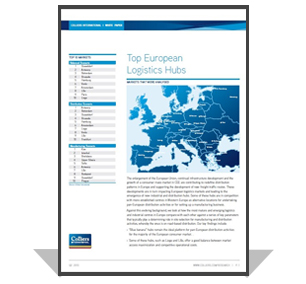The enlargement of the European Union, continual infrastructure development and the growth of a consumer mass market in CEE are contributing to redefine distribution patterns in Europe and supporting the development of new freight traffic routes. These developments are in turn impacting European logistics markets and leading to the emergence of new industrial and distribution hubs. Some of these hubs are in competition with more established centers in Western Europe as alternative locations for undertaking pan-European distribution activities or for setting up a manufacturing business.
Against this evolving background, we look at how the most mature and emerging logistics and industrial centers in Europe compare with each other against a series of key parameters that typically play a determining role in site selection for manufacturing and distribution activities, whereby the onus is on road-based distribution.
KEY FINDINGS:
- “Blue banana” hubs remain the ideal platform for pan-European distribution activities for the majority of the European consumer market.
- Some of these hubs, such as Liege and Lille, offer a good balance between market access maximization and competitive operational costs.
- Northern Italy also offers good growth potential for distribution activities, especially given the expected increase in freight traffic through northern Adriatic ports.
- From a distribution perspective, Western Europe’s dominance will be increasingly challenged by some CEE hubs, such as Prague or Bratislava, as the center of Europe gradually shifts to the east.
- Eastern Europe is the best location for low cost manufacturing but its distribution benefits remain of a local or sub-regional nature.
- Strategically located hubs in Turkey and Russia, such as Istanbul or Moscow, are increasingly integrated in the global supply chain and will gain further importance as trade links with the Far and Middle East strengthen.
- In our analysis, Southern Europe has no clear competitive advantages, but this might change on the back of structural reforms being implemented in some countries.
(This article features excerpts from the full report – please download it here)







